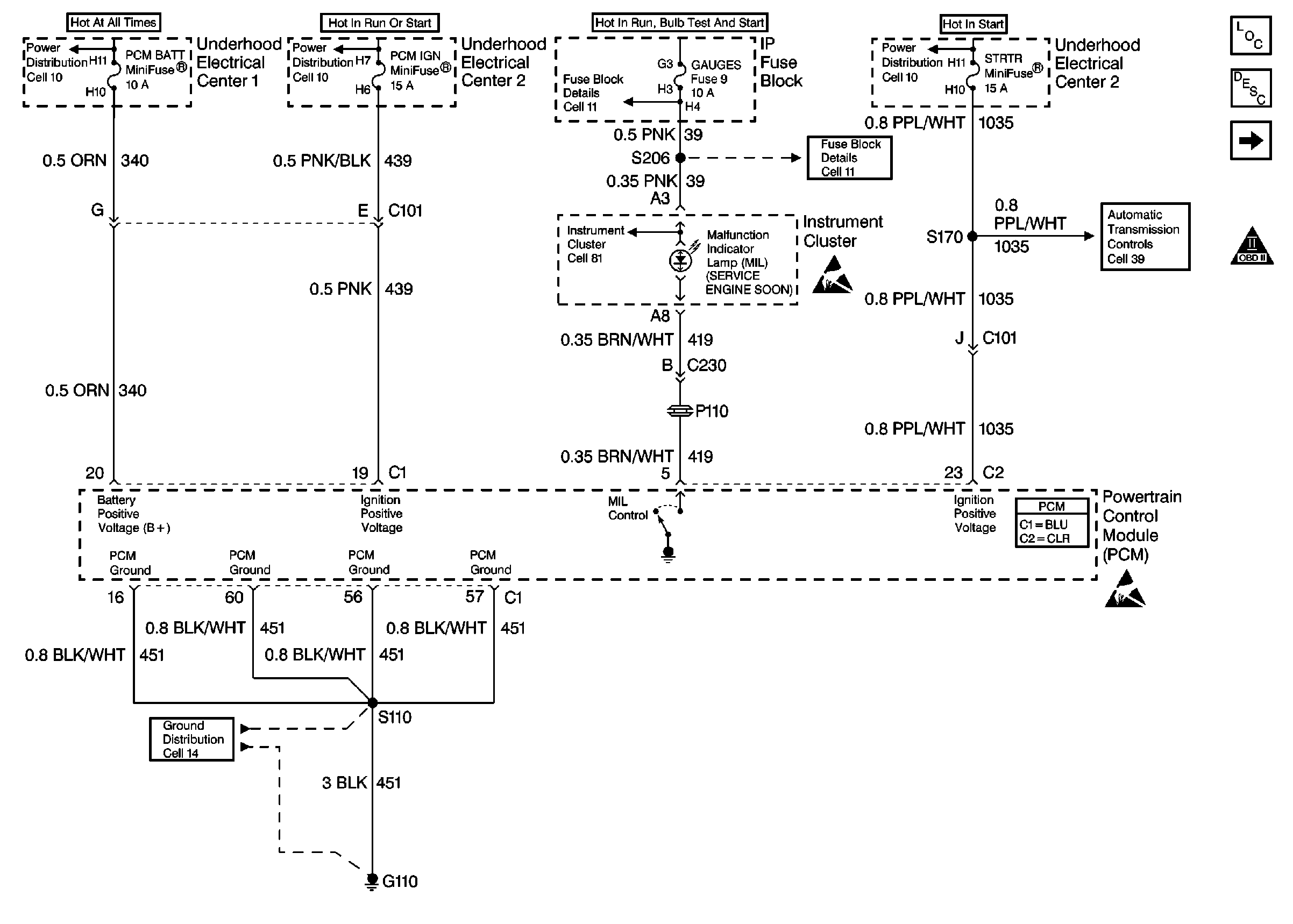Refer to
Power, Ground and MIL

.
Circuit Description
There should be a steady MIL with the ignition ON and the engine not running. Ignition feed voltage is supplied directly to the MIL. The Powertrain Control Module (PCM) turns the MIL ON by grounding the MIL control circuit. No MIL with the key ON, engine not running and the MIL DTC set suggests an open in the MIL control circuit.
MIL Operation
The Malfunction Indicator Lamp (MIL) is located on the instrument panel and is displayed as CHECK ENGINE lamp.
MIL Function
| • | The MIL informs the driver that a malfunction has occurred and the vehicle should be taken in for service as soon as possible |
| • | The MIL illuminates during a bulb test and a system test |
| • | A DTC will be stored if a MIL is requested by the diagnostic |
MIL Illumination
| • | The MIL will illuminate with ignition switch ON and the engine not running |
| • | The MIL will turn OFF when the engine is started |
| • | The MIL will remain ON if the self-diagnostic system has detected a malfunction |
| • | The MIL may turn OFF if the malfunction is not present |
| • | If the MIL is illuminated and then the engine stalls, the MIL will remain illuminated so long as the ignition switch is ON. |
| • | If the MIL is not illuminated and the engine stalls, the MIL will not illuminate until the ignition switch is cycled OFF, then ON. |
Powertrain On Board Diagnostic (OBD) System Check
Perform the Powertrain On Board Diagnostic (OBD) System Check, when the following conditions are present:
| • | When the MIL does not turn ON when the ignition switch is turned to the RUN position. See above for MIL Operation |
| • | When the MIL remains ON while the engine is running |
| • | When the MIL is flashing while the engine is running |
| • | When a driveability symptom is determined |
Diagnostic Aids
Inspect the following items:
| • | If the engine runs OK, inspect for a malfunctioning MIL, an open in the MIL control circuit, or an open in the instrument cluster ignition feed. |
| • | If the engine cranks but will not run, inspect for an open PCM ignition or battery feed or a faulty PCM to engine ground. |
Many situations may lead to an intermittent condition. Perform each inspection or test as directed.
Important: : Remove any debris from the connector surfaces before servicing a component. Inspect the connector gaskets when diagnosing or replacing a component. Ensure that the gaskets are installed correctly. The gaskets prevent contaminate intrusion.
| • | Loose terminal connection |
| - | Use a corresponding mating terminal to test for proper tension. Refer to Testing for Intermittent Conditions and Poor Connections , and to Connector Repairs in Wiring Systems for diagnosis and repair. |
| - | Inspect the harness connectors for backed out terminals, improper mating, broken locks, improperly formed or damaged terminals, and faulty terminal to wire connection. Refer to Testing for Intermittent Conditions and Poor Connections , and to Connector Repairs in Wiring Systems for diagnosis and repair. |
| • | Damaged harness--Inspect the wiring harness for damage. If the harness inspection does not reveal a problem, observe the display on the scan tool while moving connectors and wiring harnesses related to the sensor. A change in the scan tool display may indicate the location of the fault. Refer to Wiring Repairs in Wiring Systems for diagnosis and repair. |
| • | Inspect the powertrain control module (PCM) and the engine grounds for clean and secure connections. Refer to Wiring Repairs in Wiring Systems for diagnosis and repair. |
If the condition is determined to be intermittent, reviewing the Snapshot or Freeze Frame/Failure Records may be useful in determining when the DTC or condition was identified.
No Malfunction Indicator Lamp (MIL)
Numbers below refer to the step numbers on the Diagnostic Table:
-
If the MIL DTC is set, the MIL Control Circuit table will better diagnose the condition.
-
Using a test lamp connected to battery positive voltage, probe each of the PCM ground terminals to ensure that a good ground is present.
Step | Action | Values | Yes | No |
1 | Did you perform the Powertrain On-Board Diagnostic (OBD) System Check performed? | -- | ||
Does the scan tool indicate the MIL DTC set? | -- | Go to DTC P0650 Malfunction Indicator Lamp (MIL) Control Circuit | ||
3 | Inspect the PCM feed fuses. Are the fuses OK? | -- | ||
4 |
Does the test lamp illuminate? | -- | ||
5 | Probe the PCM battery feed circuit using a test lamp that is connected to a good ground. Does the test lamp illuminate? | -- | ||
Test for faulty PCM grounds or poor PCM ground connections. Refer to Testing for Intermittent Conditions and Poor Connections in Wiring Systems. Did you find and correct the condition? | -- | |||
7 |
Important: The replacement PCM must be programmed. Replace the PCM. Refer to Powertrain Control Module Replacement/Programming . Did you complete the replacement? | -- | -- | |
8 | Locate and repair open in PCM battery feed circuit or the PCM ignition feed circuit. Refer to Wiring Repairs in Wiring Systems. Did you complete the repair? | -- | -- | |
9 | Locate and repair short to ground in PCM ignition feed circuit or the PCM battery feed circuit. Refer to Wiring Repairs in Wiring Systems. Did you complete the repair? | -- | -- |
